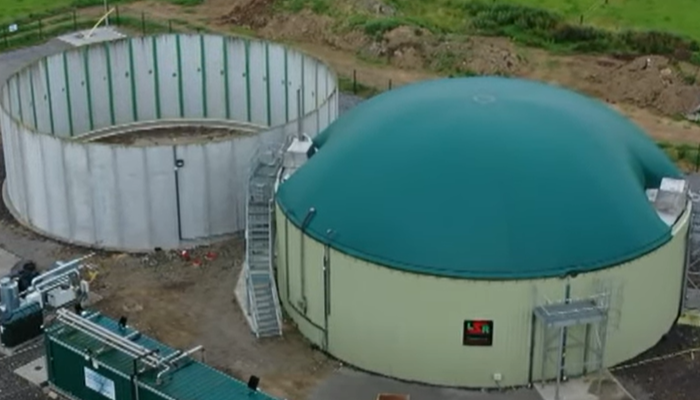06 May 2023
Agriculture’s role in biomethane production

Biomethane is a carbon neutral renewable gas made from farm and food waste, which is produced through anaerobic digestion (AD).
As part of the Climate Action Plan 2023, a biomethane production target of 5.7TWh has been set for 2030, which is equivalent to approximately 10% of the total natural gas demand in Ireland. To meet this target, a substantial quantity of feedstuff is required – be that grass or manure.
Earlier this week, a Teagasc delegation of Professor Pat Dillon, Director of Research, Dr. Fiona Thorne, Research Officer, and Barry Caslin, Energy and Rural Development Specialist, attended the Oireachtas Joint Committee on Agriculture, Food and the Marine to discuss Teagasc’s role in biomethane research and how agriculture may provide some of the feedstuffs required to AD plants.
Commenting on the role agriculture could play in such an industry, Professor Dillon said: “With over 80% of agricultural land in Ireland in grassland, the potential grass resource is substantial. Indeed, the National Heat Study showed that the available biomethane grass resource could be 4-8% of Ireland’s current gas fuel demand and that this could rise to 11% of current gas demand by 2030 if changes to livestock occurred and land was freed up from other uses.
“It is evident from this that the 5.7 TWh target by 2030 is achievable and biomass-based resources such as grass/clover silage will have a key role in meeting this potential, provided economic, environmental and social sustainability is considered.”
A prerequisite to the successful development of a biomethane AD sector in Ireland, which is agri centric, he said, is “it should be profitable and provide confidence to investors and farmers who decide to provide crop feedstocks on a contractual basis to future biomethane plants”.
Requirements
On the silage potentially sourced from agriculture to feed AD plants, Teagasc estimate that, at a national level, a total land area of 120,000ha is required, which is less than 3% of the available land area.
Furthermore, Professor Dillion added: “winter slurry from 1.3 m cattle will be required, which represents approximately 20% of all winter cattle slurry produced in Ireland. The above assumes an equal mix of grass silage and slurry on a fresh weight basis.
“The above land area requirements are based on current average yields on Irish grassland farms in which case some displacement of livestock is a likely consequence, or it could displace some existing tillage crop production,” Professor Dillon said.
However, if the quantity of forage produced at farm level increased through improved grazing practices and management, the level of displacement would be reduced.
“Research by Teagasc has indicated that there is substantial scope to increase the availability of forage from Irish livestock farms in excess of livestock requirements by improving grazing management practices.
“For example, beef farms typically utilize approximately 6 t grass DM per ha which is far below that being achieved by the top performing demonstration farms where grass utilization typically exceeds 10 t DM per ha.
“In a scenario where grassland management and utilisation practices improve, the Climate Action Plan 2023 targets could be met with little livestock displacement,” Professor Dillon told the committee.
Increased production without additional nitrogen
It was noted, however, that increasing the availability of forage should not be achieved through increased nitrogen fertiliser applications, due to the impact of greenhouse gas offsetting and forage production costs.
On this Professor Dillon said: “Current research by Teagasc indicates that the production of forage crops with the capacity to produce high yields with low levels of fertiliser nitrigen such as red and white clover-based crops are best placed to meet the feedstock requirements for an AD industry.
“Furthermore, improving grasslands to support a biomethane industry must be consistent with the national biodiversity strategy which aims to conserve biodiversity in the wider countryside through the enhancement of high nature value farmlands.”
The role of digestate, the residue of feedstock that remains following the digestion process, was also discussed. This is an important resource that could be processed to replace chemical nitrogen fertiliser. Teagasc is currently investigating a range of processing technologies to both reduce emissions from land spreading and to recover digest digestate nutrients to replace chemical fertiliser.
“The nutrient content of the feedstock is largely retained and therefore, digestate is a valuable nutrient for grassland and cereal crops and can replace artificial fertiliser.
“Nutrients in agricultural AD digestate, particularly nitrogen, are more freely available for plant uptake than in untreated organic slurry or waste sources.
“For example nitrogen availability in digestate is increased by up to 10% and for this reason, application using low emissions slurry spreading technologies (LESS) and/or post-processing options such as separation, acidification or ammonia recovery is recommended.” Professor Dillon stated.
Farm diversification
Professor Dillon also spoke on the potential of farm diversification through the production of feedstuffs for the AD industry, adding: “The use of grass resources for AD biomethane has a distinct advantage from a farm diversification perspective in that it is a familiar practice for livestock and crop farmers.
“In this context, the willingness to adopt land use change is being assessed by an SEAI-funded Farm Level Economic, Environmental and Transport modelling project led by Teagasc, which is identifying farm scale, landscape level and national level economic and environmental implications of farm supplied alternative feedstock for AD at a regional level.
“Clearly, the financial returns to the farmer will have an important bearing on the acceptability of producing grass for AD biomethane. The traded value for grass silage can be used as a guide for this diversification option; however, an additional premium is likely necessary, the extent of which being influenced by individual farmer’s commitment to their existing enterprise and prevailing attitude to innovation and change,” he said.
To re-watch the entire committee meeting, click here. Professor Dillon’s opening statement from the committee meeting is available here. For more information on biomethane, click here.
